In the post A trip to South Wales (Part 1) I described the journey as far as my arrival in Swansea.
Swansea
It remained a warm, sunny day as I left the station to explore a little of the town. The pleasing 1930s stone facade of the station building built by the Great Western Railway was echoed by the Grand Hotel which faces it. Neon signs atop the hotel read 'Croeso i Abertawe' and, for the benefit of non-Welsh speakers, 'Welcome to Swansea'.
 Swansea Railway Station.
Swansea Railway Station.
 The Grand Hotel, Swansea.
The Grand Hotel, Swansea.
It appears Swansea is both a city and a county, with a total population around a quarter of a million. I continued along the High Street which has some decent buildings but much of the area was devastated during World War II air raids. The remains of Swansea Castle face Castle Square with its fountains and "Swansea's Big Screen". I continued along Wind Street which is largely given over to Bars and Restaurants to reach the dual carriageway of Quay Parade.
This marks the start of the 'Maritime Quarter'. I could see the neo-classical Swansea Museum built in 1841 and also the more modern National Waterfront Museum. It was only on my return home I read that the National Waterfront Museum
"is housed in a magnificent building that elegantly combines old and new architecture. A Grade II listed former dockside warehouse (formerly the Swansea Industrial & Maritime Museum) built in 1902, contrasts with a spectacular new glass and slate structure designed exactly a century later, by Stirling Prize-winning architects Wilkinson Eyre".I wasn't in the mood for culture and even eschewed the former docks which now appear to be a marina for pleasure craft. In addition, on the grass outside the museum there was some sort of "Meet the Emergency Services" exhibition and the air was rent with almost continuous screeching and wailing as the various types of audible warning used by emergency vehicles were demonstrated. I decided to return to the railway station and continue to Cardiff.
On to Cardiff
I took a few more pictures around the 4-platform terminus at Swansea, whilst waiting for the next Cardiff service, from platform 1.
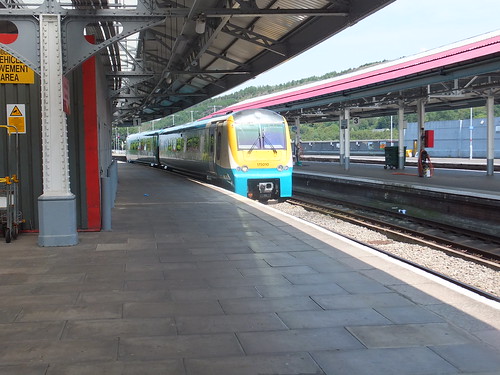 DMU 175010 arriving at platform 1, Swansea.
DMU 175010 arriving at platform 1, Swansea.
This was a 2-car Class 175 which changed direction at Swansea at Swansea so as to leave the station on the Up Main, passing Landore Depot on our left (where the First Great Western HS125 trains serving Swansea are serviced).
 Landore Depot, Swansea.
Landore Depot, Swansea.
Eight miles brought us to our first stop at Neath, just under six more miles took us to our second stop at Port Talbot Parkway (where the Signalling Centre controlling the area is located). Beyond Port Talbot, the extensive Tata Plant (formerly Corus, formerly British Steelat Margam lay on our right, with its two remaining blast furnaces (numbers 4 and 5), Basic Oxygen Steel Plant and the hot and cold rolling mills. There's a Wikipedia article about the site here and an excellent Visitor Guide produced by Tata here. Part of Port Talbot's output is shipped to Shotton for coating - there's a little about the Shotton plant in my earlier post By rail to Liverpool (Part 1).
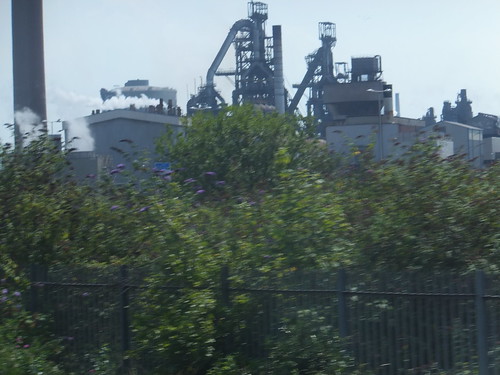 A glimpse of the surviving blast furnaces at Margam.
A glimpse of the surviving blast furnaces at Margam.
There are still extensive sidings serving the steelworks at Margam Knuckle Yard, then the aspect is less industrial. Our next stop was at Bridgend where, in addition to the two through platforms, there are two bays. Bay 1A on the Down side serves the double-track line to Barry whilst Bay 4 on the Up side serves the single line to Maesteg. Then we ran non-stop the 20 miles to Cardiff Central (the last 14 of which were under the control of Cardiff Signalling Centre). Our journey from Swansea had taken just over 50 minutes.
Cardiff Central
In the 1930s, the Great Western Railway provided Cardiff Central with a handsome set of station buildings in Portland stone which continue to distinguish this important station. I took a few pictures around the main line platforms and located the Signalling Centre on the Down side at the western end of the station. I took a lousy picture against the sun which also features Brains Brewery. Steps and lifts take passengers from platform level to two subways running across the station to the main building on the north side. Automatic ticket gates give access to an airy booking hall with three wide entrances leading to a pedestrian plaza and the city. The station buildings are listed Grade II. The weather was still hot and I was starting to wilt a little so I decided to stay in the vicinity of the station, rather than exploring the city.
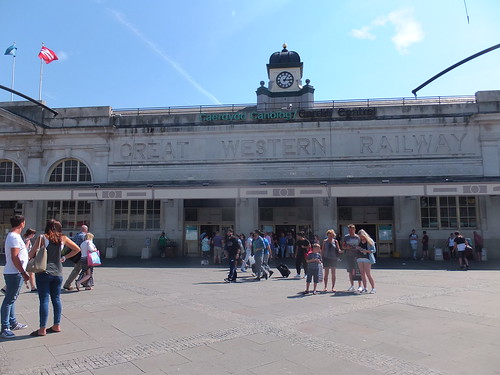 Cardiff Central Station viewed from the pedestrian plaza.
Cardiff Central Station viewed from the pedestrian plaza.
The name of the original station owner, 'GREAT WESTERN RAILWAY' is proudly incised into the stone in large letters and is clearly visible. In contrast, the modern sign above reading 'Caerdydd Canalog/Cardiff Central' was almost invisible in the bright sunshine. I think the sign is internally lit so matters may be improved at night.
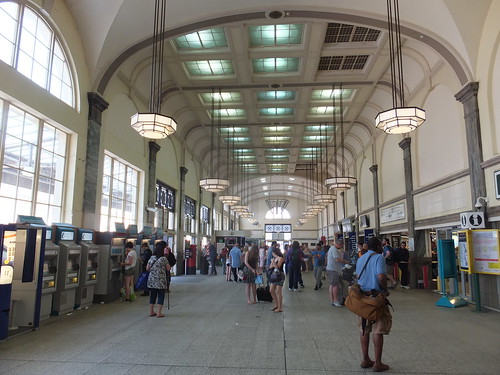 The Booking Hall.
The Booking Hall.
The Booking Hall with its Art Deco fittings is still relatively uncluttered, although I didn't find the modern signage (in English and Welsh) very informative, particularly when I tried to find platform 0. Platform 0 is a fairly recent creation and falls outside the system of automatic ticket barriers.
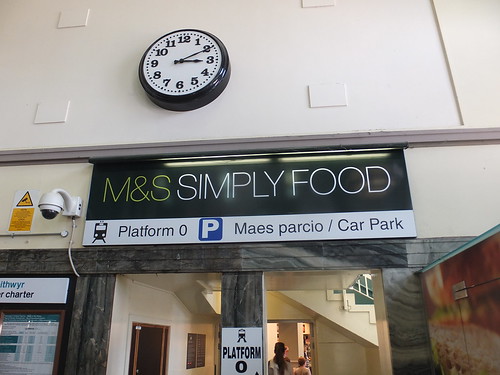 'M & S Simply Food'.
'M & S Simply Food'.
It took me a few moments to realise that the approach to 'M & S Simply Food' also gave access to the car park and, at a higher level, platform 0 for trains to Ebbw Vale. Whereas the original station has fairly extensive platform canopies, platform 0 is equipped with a series of 'bus shelters' distributed along its length.
I decided I'd press on to Newport, so I caught the next service east. Approaching Newport, on our right we passed the siding connections leading to the Celsa Steel UK plant at Tremorfa. Their website here gives an introduction to their processes and products including reinforcing products ('rebar'), wire rod, bars and light sections.
Newport
My last visit to Newport was in 2012 when OLCO held 'Lionsmeet 2012' there (report here) and on that occasion I travelled by train and took a few pictures around Newport station. On the present trip, I added a few more railway pictures and had a brief walk outside the station but I was starting to flag a little so I was soon back on the station awaiting my train back to Shrewsbury.
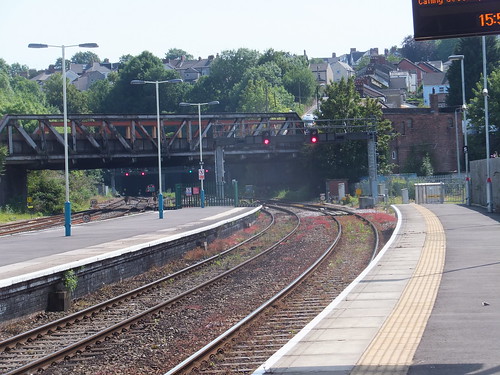 Newport: View looking west from platform 4 showing the girder road bridge and, beyond, Newport Old Tunnel (L) and Newport New Tunnel (R).
Newport: View looking west from platform 4 showing the girder road bridge and, beyond, Newport Old Tunnel (L) and Newport New Tunnel (R).
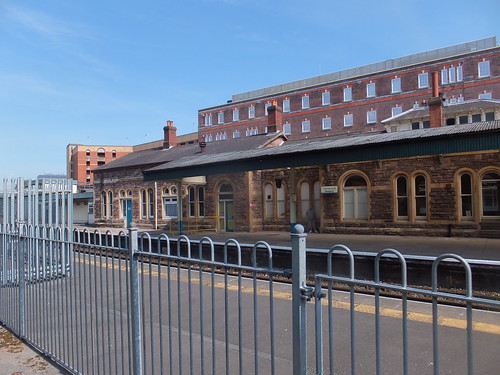 Newport: North Elevation of station buildings on platform 3 viewed from the footpath adjacent to platform 4.
Newport: North Elevation of station buildings on platform 3 viewed from the footpath adjacent to platform 4.
Shrewsbury-Hereford-Newport Line
This line has been heavily 'rationalised' so there's not so much of railway interest. There are a number of stations and, for the most part, signalling is Absolute Block with semaphore signals (Western Region style). Pontypool is reduced to an island platform and little else. Abergavenny retains its signal box and a smattering of sidings.
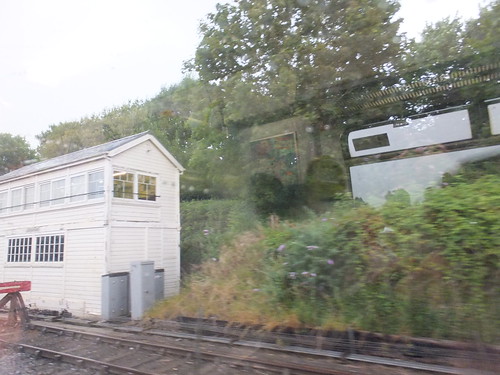 Abergavenny signal box.
Abergavenny signal box.
Between Abergavenny and the remote Tram Inn signal box there are still fifteen accommodation level crossings.
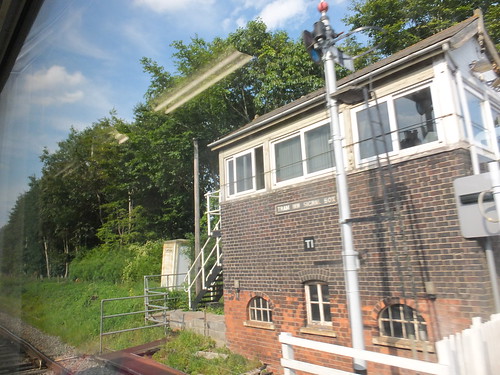 Tram Inn signal box.
Tram Inn signal box.
Six miles further on we paused at Hereford. There were once four railways fighting for access, with a complex of lines and junctions. But now, one signal box controls the area. Originally called 'Ayleston Hill', it is now simply 'Hereford'. This brick structure has been fitted with uPVC window units. Local points remain mechanically operated: more remote connections are power operated. Running signals seem to be multiple aspect colour light.
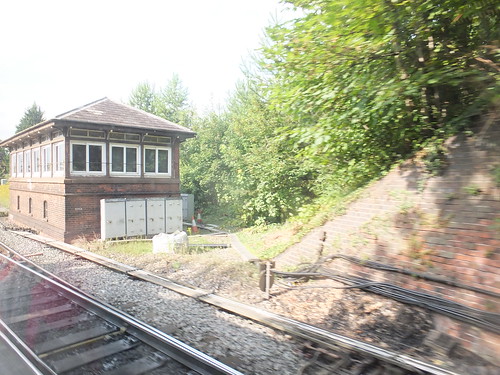 Hereford Signal Box.
Hereford Signal Box.
Similarly, the station which was once styled 'Hereford (Barr's Court)' is now simply 'Hereford'.
 Hereford: Station building on Down Main Platform.
Hereford: Station building on Down Main Platform.
Five miles beyond Hereford, we passed Moreton-on-Lugg signal box with its barrier crossing and connections to sidings which originally served a Royal Army Ordnance Corps Depot.
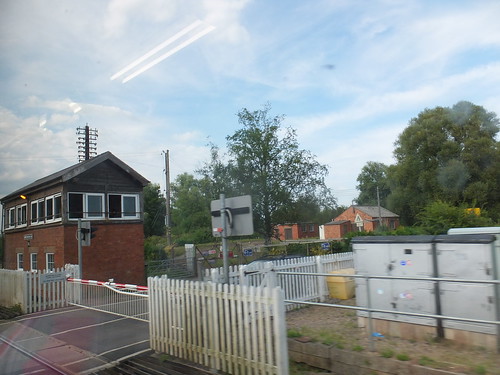 Moreton-on-Lugg signal box.
Moreton-on-Lugg signal box.
Three miles further on, we passed through Dinmore Tunnel (1054 yards long). There are two single-bore tunnels and the Down Line tunnel is a few yards away from our tunnel and at a slightly lower level. The Down Line tunnel dates from 1853 and the Up Line tunnel from 1891.
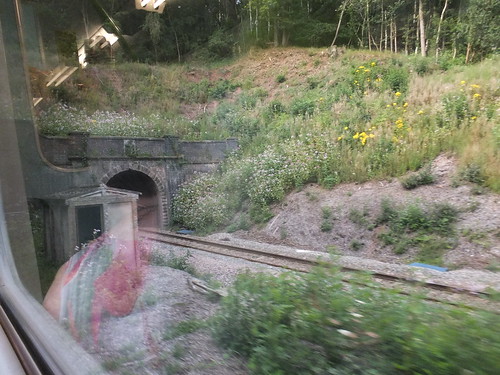 Dinmore Tunnel: The southern tunnel mouth on the Down Line.
Dinmore Tunnel: The southern tunnel mouth on the Down Line.
Another five miles took us to Leominster with its big, squat signal box.
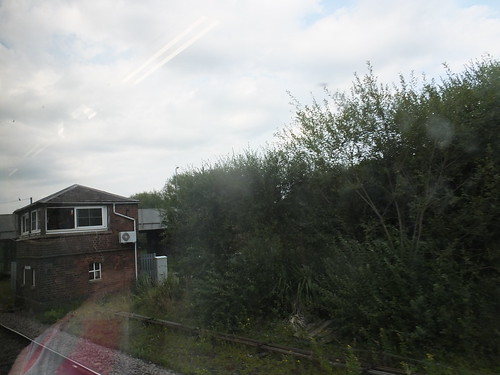 Leominster signal box.
Leominster signal box.
There are nineteen level crossings between Leominster and Craven Arms - mostly minor and user-worked but with some automatic with barriers on busier roads. I managed to get a shot of timeless Stokesay Castle as we sped by.
 Stokesay Castle.
Stokesay Castle.
I also took a shot of Dorrington signal box but then I relaxed on the last few miles to Shrewsbury.
 Dorrington signal box.
Dorrington signal box.
At Shrewsbury, I changed to a Wolverhampton train and made my weary way home after an interesting, if tiring, day.
Well, that's an impression of how it is now. As time permits, I hope to add some notes on how it was, pre-Grouping and pre-Beeching.
Map of Railways described above in Pre-grouping period
Up until the Railways Act 1921 which grouped railway companies into the 'Big Four', there was a plethora of independent railways. The three map fragments below show South Wales, Newport to Leominster and Leominster to Shrewsbury and are taken from the 'Railway Map of England & Wales, 11th Edition', published W. & A. K. Johnston. The explanation of the colours or numbers on these map fragments is shown in the table below.
| Colour or number | Railway |
| Blue | Great Western |
| Brown | London & North Western |
| Green | Midland |
| Green/white | Taff Vale |
| 1 | Barry |
| 3 | Brecon & Merthyr |
| 37 | Port Talbot |
| 39 | Rhonnda & Swansea Bay |
| 40 | Rhymney |
| (named) | Neath & Brecon |
Map of Pre-grouping Railways in South Wales
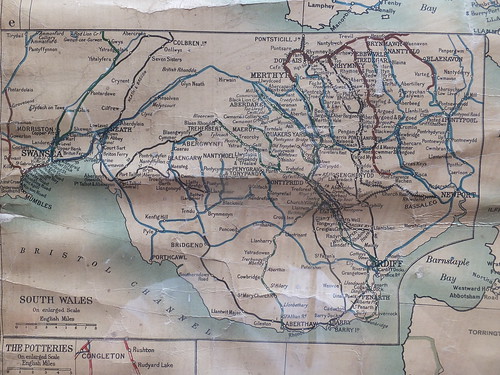
Click for larger image.
Pre-grouping railways in South Wales.
Map of Pre-grouping railways from Newport to Leominster

Click for larger image.
Pre-grouping railways from Newport to Leominster.
Map of Pre-grouping railways from Leominster to Shrewsbury
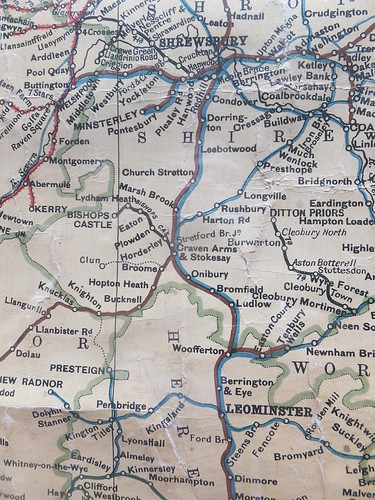
Click for larger image.
Pre-grouping railways from Leominster to Shrewsbury.
Some time after the trip, I assembled some historical and other data which you can find in Part 3.
Book References
[1] 'A Regional History of the Railways of Great Britain: Volume 12 South Wales by D. S. M. Barrie, published by David & Charles (ISBN 0-7153-7970-4).
Track Diagrams
[1] 'Track Layout Diagrams of the GWR and BR WR: Section 38 Newport' by R. A. Cooke, published by R. A. Cooke 1980.
[2] 'Railway Track Diagrams Book 3: Western', published by Trackmaps (ISBN: 0-9549866-1-X).
[3] 'Track Layout Diagrams of the GWR and BR WR: Section 38 Newport' by R. A. Cooke, published by R. A. Cooke 1980.
Related articles on other sites
Cardiff Central Railway Station (Wikipedia).
Cardiff Central Station (National Rail).
Related articles on this site
Part 1.
Part 3.
My pictures
General:
Swansea.
Newport, Gwent.
Railway pictures:
Swansea area railways.
Cardiff's railways.
Newport Station, Gwent.
Shrewsbury-Hereford-Newport line.
